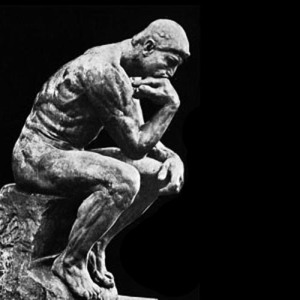~ Body and Mind in Spinoza’s Ethics: a challenge to the Cartesian cogito ~
by Vic Briggs

Spinoza (1632-77) vs Descartes (1596-1650)
Part I
Introduction
“Although he lived three hundred years before our time, the spiritual situation with which Spinoza had to cope peculiarly resembles our own. The reason for this is that he was utterly convinced of the causal dependence of all phenomena… In the study of this causal relationship he saw a remedy for fear, hate and bitterness, the only remedy to which a genuinely spiritual man can have recourse.”
— Albert Einstein
Philosophy is generally associated with the search for knowledge of the self and of the world, and Baruch Spinoza (1632-77) was faithful to these traditional preoccupations. He dedicated his life’s efforts to framing an epistemological theory of the universe explaining the complex lattice of man and his universe.
Feuerbach regarded Spinoza as the emancipator of reason in a new era, with the Ethics more than any other philosophical work establishing the foundation for the force of reason.
In one of his epigrams on Spinoza, Althusser voiced the philosopher’s belief that the truth of a philosophy exists in its effects. It is certainly difficult to find a modern philosopher other than Spinoza whose system has been contended with more passion and determination by fractions otherwise opposed in thought, but united in their denunciation of his works, often without making the effort of reading them:
“I have not read him, but who would want to read every obscure book written by a madman? But I have it from many who have read him that he was an atheist and pantheist, a teacher of blind necessity, and enemy of revelation, a mocker of religion, and thus a destroyer of the state and of civil society; that he was in short an enemy of the human race and died as such. He therefore deserves the hatred and loathing of all friends of humanity and true philosophers.” (Philolaus, in Herder’s dialogues on Spinoza’s system)
In fact the geometrical form of Spinoza’s Ethics with its apparent rigid definitions and axioms makes the undertaking a difficult one for the uninitiated reader, a frustration clearly expressed by Montag:
“In reading the definitions I could not entirely escape the feeling that each term referred to the others which in turn referred to it in what appeared to be a circle of empty abstractions: substance, modes, attributes, essences.”
For the message of Ethics however, this geometrical form was indispensable. Spinoza wanted the reader to pay little attention to the language used, and concentrate on the ideas that he endeavoured to convey by the means of that language.
Ideas, unlike language, are clear and distinct and based on real definitions, therefore being less prone to confusion in the thinker’s opinion (here Spinozian and Cartesian opinions converge).
This reliance on real definitions cannot be without assumptions and there are obvious difficulties with such an approach, as an interpreter of the text can never be sure of whether they are being mislead by the language of the text to ideas other than those intended.
“the apparent impenetrability of his writing is in some measure the opacity of the present to itself”
— Montag.
Yet it is not this that had caused so many to refute his philosophy. There were countless accusations of atheism, fatalism and pantheism regarding Spinoza’s Ethics.
Perhaps it is for this reason that philosophers who benefited from the necessary “distance” conferred by time, such as Althusser for example, would be able to regard the work’s supposed atheism or heresy as one of its distinct positive aspects, in being able to express a revolutionary spirit representative of a history repressed and denied.
Other important criticisms included the apparent confusion of God with the world or with nature that Spinoza’s definition of substance infers. Such accusations attempted to perpetrate the idea that Spinoza’s God was a part of a finite, degradable world. In this respect the critics failed to understand Spinoza’s theory of substance, modes and attributes and made the false assumption that the attribution of extension to God would somehow render him corporeal, which was certainly not Spinoza’s intention. Spinoza’s particular emphasis on the distinction between Natura naturans – God – another name for the attributes, and Natura naturata – the totality of finite things – disproved his critics’ claims when observed.
What then determined so many to refute his philosophy? It was his departure from the philosophical mainstream of his time, his radical dissonance with orthodox theology and his challenge to accepted dualist conceptions of minds and bodies, God and substance, activity and passivity.
Leibniz, among many others critics, had deprecated Spinoza’s philosophy as exaggerated Cartesianism. Spinoza’s philosophy has indeed been greatly influenced by Descartes. In many ways, his own philosophy speaks to those issues raised by the Cartesian self, and although many similarities of approach exist, the conclusions the two philosophers reach are radically opposed.
To understand these distinctions more clearly it is necessary to take a closer look at Spinoza’s system of thought in the Ethics and his development of the theory of bodies and minds united through ideas and their objects.
Divided in five major parts, Spinoza’s Ethics offers more than a philosophy of morals, as the title may entitle one to expect. The work consists in short of a cosmology in the first part establishing the concepts of God, Nature, substance, attributes and modes; the second part could be conceived of as a psychology identifying the relation between human bodies and human minds and addressing the question of the nature of man; the third and fourth parts contain a psychology of the emotions which to some extent appears as a theory of human happiness; and finally the fifth part fully justifies the title of the work as Ethics, although expounding an ethics that would appear unfamiliar to his contemporaries, with no dogmatic good and evil expressed, morality becomes the tenet of individual’s understanding of emotions through reason.
Subsequently, I will attempt to show that, while Spinoza may have adopted a Cartesian approach (that of mathematical method) and language, most concepts appear transformed in his philosophy. The ‘borrowed’ notions were used in new ways and his thought developed more often in opposition to Descartes’ ideas rather than following them.
Note to my readers: Originally I intended to make this post available on the Monday following my previous post. Those of you who expressed an interest in the subject deserve an explanation for my renewed absence (I am in two minds regarding how explicit or otherwise I ought to be in this respect), but first I would like to apologise for the delay.
This introduction is by no means exhaustive. It neither could be, nor did it aim to be so. It assumes a degree of acquaintance with Spinoza’s work and is intended as a mis-en-scene for the discussion of the relationship between body and mind in Spinoza’s Ethics and the challenge presented by Spinoza’s theories to the model of the Cartesian cogito on which I will expand in subsequent Philosophy Mondays posts.
All comments and questions are welcome. I can’t promise that I will be able to answer all to your satisfaction, but I can promise to do my best.
If you are new to Spinoza, the following webpages contains a few biographical details and an overview of his work: http://www.philosophypages.com/ph/spin.htm and http://plato.stanford.edu/entries/spinoza/










